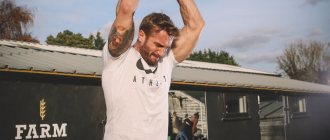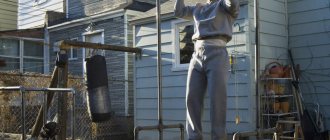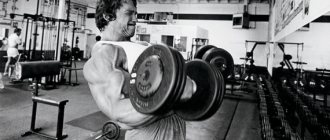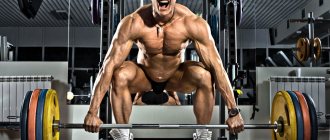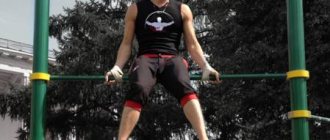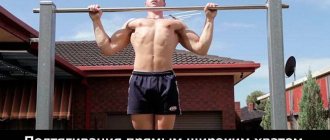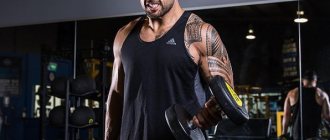Table of push-ups and pull-ups. Reverse and forward progression method
This table of pull-ups on the horizontal bar will help you achieve the desired result; you will be able to do at least 25 pull-ups.
Reverse progression method
You need to do pull-ups for 6 days; on the 7th, be sure to take a break from physical activity. You need to practice for 4 weeks, constantly changing your grip. In week 5, continue the training program using the direct progression method. Then you should return to the first version of the program.
Method diagram in table form
The presented training program is designed for beginners; in 5 weeks you can easily reach 25 times in 3 approaches. Those who have a standard significantly higher than the presented amount can catch up by doubling all the numbers in the table. This way you can learn to do it 30, 50 and 100 times, the main thing is desire and regular training.
There are two types of grip in pull-ups - forward and reverse.
With a direct grip, the fingers of the hands move away from you, with a reverse grip, they move towards you. If the hands are located at shoulder level - a narrow grip, 10 cm wider - medium, and if they are spread as far apart as possible - a wide grip.
An alternative method for doing pull-ups up to 20-25 times
As an alternative to the training plan described above to achieve 20-25 pull-ups in one approach, you can consider a technique such as ladder exercises. This method of training is that you start doing 1 pull-up first, then jump off, pause, do 2 pull-ups, jump off, do 3 pull-ups, and so on until the maximum number when you are no longer able to do one more pull-up, and then “move.” in the opposite direction,” reducing the number of pull-ups with each new approach.
The advantages of this technique are that you are essentially training according to an individual program that meets exclusively your physiological capabilities and your physical form. At the same time, you can choose the grip width on the horizontal bar that suits you best, remembering that the width determines which muscle group is more involved in the process of pulling up on the bar.
Pull-up technique on the horizontal bar
If you work out at home, you need to have a durable horizontal bar. After all, in the future you will need to do pull-ups with weights. And if you also love dips and need to do reverse crunches, then the Sturm simulator, specially designed for full-fledged home workouts, will help you.
Next, the pull-up technique on the horizontal bar is very important. Yes, yes, pull-ups have their own technique. When you are in the lower position you need to swing slightly forward.
This is a movement invisible to the prying eye. And from there you can pull yourself up. Descending from top to bottom, you need to get to the point below that is slightly ahead and immediately go up.
The grip should be straight (now we are talking about this pull-up). A direct grip is when you place your hands on the horizontal bar from above. If the hands are placed from below, this is a reverse grip.
Particular attention should be paid to the grip width.
You will perform any exercise best if you are comfortable doing it. Those. in our case, if you grab the horizontal bar with a grip that is optimally comfortable in width, then you will do more pull-ups. Right?
If you lift yourself wide, imitating other athletes, you will pull up less than you could. This means that the grip must be optimal. Not too wide and not too narrow. Comfortable.
A narrow grip is used for other purposes.
The optimal grip width is such a grip when, with your chin tucked in, your hands are held above the bar, and your hands hold the bar slightly wider than your shoulders. Inhale in the lower position, and exhale in the upper position. We figured out the technique of performing the exercise.
Some tips
Among them:
- professionals know by heart that before performing any set of exercises, you should do a warm-up. It is simply necessary, as it allows you to avoid injuries and warm up your muscles;
- After finishing any workout, you should always stretch. After the load, the muscles should relax;
- you should believe in yourself and strive for your cherished dream, namely a large number of pull-ups. The complex, of course, will help with this, but if there is no desire, and laziness arises, then it will not be possible to achieve results;
- if, due to your personal well-being, you are not confident in full recovery of strength, it is better to slow down the pace when doing pull-ups or take a little longer breaks between approaches, but you should not skip days;
- Music will help tone you up;
- You can arrange something like a competition with your friends, but you should perform the exercise the number of times indicated in the above table in the figure.
Correct execution technique is the key to a good result. Quality plays an important role in training
We also recommend studying this topic:
Pull-up technique for pumping up muscle mass
5260 0 0
Program for Beginners
The first thing beginners need to do is learn how to do pull-ups technically correctly. Pull-ups are performed not by the biceps and forearms, but by the latissimus dorsi muscles. This is the basis on which all other exercises are built. The easiest way to do this is to try to bring your shoulder blades together as you lift your body up. No need to swing.
The pulling movement itself should be performed not due to some kind of impulse, but due to compression of the latissimus dorsi muscles. It is quite difficult to feel this movement, and often it takes more than one month of training. But when you learn to do this, your back will begin to grow at an enviable speed. Another option is to use straps, they help to “turn off” your arms.
Before you start performing the complexes, you need to do a test - do pull-ups with a wide grip for the maximum number of times. If you manage to do more than 5, skip the first program and immediately proceed to the second. If you manage to do 1-4 times, start with a simple 4-week program to increase the number of pull-ups:
| Week 1 | |
| Number of approaches | Number of repetitions |
| Day 1 | |
| 5 | 1, 1, 1, 1, maximum |
| Day 2 | |
| 5 | 1, 1, 1, 1, maximum |
| Day 3 | |
| 5 | 1, 2, 1, 1, maximum |
| Week 2 | |
| Number of approaches | Number of repetitions |
| Day 1 | |
| 5 | 1, 2, 1, 1, maximum |
| Day 2 | |
| 5 | 2, 2, 2, 1, maximum |
| Day 3 | |
| 5 | 2, 2, 2, 2, maximum |
| Week 3 | |
| Number of approaches | Number of repetitions |
| Day 1 | |
| 5 | 2, 3, 2, 2, maximum |
| Day 2 | |
| 5 | 3, 4, 3, 3, maximum |
| Day 3 | |
| 5 | 3, 4, 3, 3, maximum |
| Week 4 | |
| Number of approaches | Number of repetitions |
| Day 1 | |
| 5 | 3, 4, 3, 3, maximum |
| Day 2 | |
| 5 | 4, 5, 4, 4, maximum |
| Day 3 | |
| 5 | 4, 5, 5, 5, maximum |
The horizontal bar training program for those who were able to perform more than 5 pull-ups is designed for 3 sessions per week. Other exercises have already been added here. Each workout is quite short, no more than 30 minutes.
| Monday | ||
| "Jumping" pull-ups | 3x10-15 | |
| Horizontal pull-ups on a low bar | 3x10-12 | |
| Wide grip pull-ups | 3x5-7 | |
| Hanging on the horizontal bar | 4xmaximum | |
| Wednesday | ||
| Hanging leg raises to the bar | 3x8-10 | Makatserchyk - stock.adobe.com |
| "Janitors" | 3x6-8 | |
| Imitation of French press on a low bar | 4x10-15 | |
| Hanging on the horizontal bar | 4xmaximum | |
| Friday | ||
| "Jumping" pull-ups | 3x10-15 | |
| Head pull-ups | 3x5-7 | |
| Close-grip pull-ups | 3x4-6 | |
| Hanging on the horizontal bar | 4xmaximum |
Once you can complete the entire amount of work without much effort, begin to slowly increase the number of repetitions and approaches. Also, from time to time, measure your progress separately in pull-ups, because this is the basis of all exercises on the horizontal bar. If you can easily and technically perform 15 reps, it's time to move on to heavier training for more experienced athletes.
Another great option for increasing the load is to use additional weights. A backpack filled with something heavy, such as sandbags or water bottles, works well here.
httpv://www.youtube.com/watch?v=embed/dLjRPXKdZ6c
1st month of pull-up training
Let me remind you that before any workout, a warm-up is required, and after each day of training, one day of rest is required. So we study no more than three times a week, for example: Monday, Wednesday and Friday. For training, either a horizontal bar on the sports ground in the yard, or a wall-mounted home horizontal bar, or horizontal bars in any fitness center are suitable. Here is a weekly plan for the first month of training.
| Monday (rest 1-2 minutes between sets) | |||
| starting | average | good | |
| Approach 1 | 1 | 2 | 4 |
| Approach 2 | 1 | 2 | 4 |
| Approach 3 | 1 | 2 | 4 |
| Approach 4 | 1 | 2 | 4 |
| Approach 5 | 1 | from 2 to maximum | from 4 to maximum |
| Wednesday (rest 1-2 minutes between sets) | |||
| Approach 1 | 1 | 2 | 4 |
| Approach 2 | 1 | 3 | 5 |
| Approach 3 | 1 | 3 | 5 |
| Approach 4 | 1 | 2 | 4 |
| Approach 5 | 1 | from 3 to maximum | from 5 to maximum |
| Friday (rest between sets 1-2 minutes) | |||
| Approach 1 | 1 | 2 | 4 |
| Approach 2 | 1 | 3 | 5 |
| Approach 3 | 1 | 3 | 5 |
| Approach 4 | 1 | 3 | 5 |
| Approach 5 | from 2 to maximum | from 3 to maximum | from 5 to maximum |
You will have four such weeks, during which time the number of maximum pull-ups should increase by at least 2-3 times per approach.
When doing pull-ups, you can keep your legs straight, or you can bend your knees, you can even cross your bent legs, whatever is comfortable for you!
How to start developing muscles
The very first and basic exercise: grab a horizontal bar and hang on it for several minutes.
Then hang again, but only this time begin to slowly contract the muscles and stretch upward. And stopping at the top point, stay in this position for as long as possible. After that, start slowly going down. When you go down, straighten your spine as much as possible, hang a little and jump off carefully. I also advise you to do push-ups and pump up your abs at home, this will allow you to stay in shape when you won’t be able to exercise on the horizontal bar and uneven bars, and if you’re already doing this, then building up will be much easier and faster.
If your body has not yet adapted to the loads that lead to weight gain, you need to gradually increase the intensity of your training in proportion to muscle development. For example, do a warm-up (as described above) and do pull-ups on the horizontal bar as many times as possible for you at this stage. Then rest for a couple of minutes and do some pull-ups again. Rest again and do the third approach. At the very beginning of training, you should not expect outstanding results from yourself, and in the absence of such, in no case should you be upset or engage in self-flagellation. Everything takes time.
Here are a few basic exercises that will help you gain weight on the horizontal bar:
1) Wide-grip chest pull-ups
Grab the horizontal bar with a straight, wide grip, and while inhaling, pull yourself up to a position where your chest is at the same level as the horizontal bar itself, while your elbows are fixed and in the same place. After holding this position for a fraction of a second, slowly and at the exit, lower yourself to the starting position.
2) Pull-ups on parallel bars
Grasp the bars with your hands with a regular grip so that your palms face each other. At the same time, throw your legs back onto the bars, fixing them with your feet. After this, hang on your straight arms and begin to pull yourself up as high as possible, keeping your back straight.
3) Dips
Get into exactly the same position as described in the previous exercise and do push-ups as if you were on the floor. At the same time, try to keep your back straight, and you can even bend lower so that the amplitude of muscle contraction is maximum.
4) Close grip pull-ups
Grasp the bar of the horizontal bar so that the maximum distance between your palms is approximately 10 centimeters. At the same time, the hands are closed into a fist. And pull yourself up to a position where your wrists touch your chest. With a direct grip, the maximum load is placed on the biceps, and with a reverse grip, the maximum load is placed on the muscles of the forearm.
5) Wide grip pull-ups with rear bar
A very powerful exercise for developing the shoulder muscles and latissimus dorsi. You need to grab the crossbar with a straight, wide grip and pull yourself up so that in the raised position your head is in front of, not behind the crossbar, and the horizontal bar touches the stove from behind.
Also, do not forget to eat well and nutritiously so that your muscles can take the necessary amount of proteins and amino acids for growth. Good luck!
MY
about the author
Greetings, dear friend!
My name is Egor Sheremetyev. On my website you can find answers to many questions regarding dating, dating and building relationships with girls.
Please give your opinion about my article
For me it is very important, because... I made the blog for you and I want it to be really useful. Your opinion will allow me to verify this or become an idea for a new article
Your opinion will allow me to verify this or become an idea for a new article.
Mass training program
First, let's look at the exercises that will need to be performed to achieve significant muscle growth.
Wide grip pull-ups
This exercise is aimed at developing the latissimus muscles:
- Find the nearest horizontal bar. It is desirable that it be high enough. The scheme for working with weights implies a horizontal bar that is not too high, but not too low. It is important that your feet do not touch the ground, but that you can easily descend without jumping.
- Grab the bar with a wide overhand grip.
- Using the strength of your back muscles, pull your elbows toward your body, bringing your chin above the bar. Hold at the top for 1 second, slowly lower back down.
Aim to do 4 sets of 5-6 reps after warming up. To warm up, you can do pull-ups without weight 5-10 times, depending on your physical fitness.
Close-grip pull-ups
This is an important exercise for the mid back and biceps. If you pay attention, it’s much easier to pull yourself up this way than in the previous case:
- Grasp the horizontal bar with a narrow reverse grip.
- Using the strength of your back and arms, lift yourself up so that your chin is above the bar. There is no point in lingering at the top, since in this position there is no maximum muscle tension.
- Slowly lower yourself to the starting position.
You need to perform 3-4 sets of 6-8 times with weight.
Parallel grip pull-ups
To do this, you will need a horizontal ladder or a special horizontal bar with parallel handles. This is a very convenient option for pumping the lower part of the latissimus muscles.
- Grasp the cross bars of the horizontal ladder. To do this, you need to position yourself facing her side so that your head freely goes above the bars.
- Do 4 sets of 6-8 reps, pulling the bars toward your chest.
How to combine exercises for muscle growth
In order to properly pump your back muscles, it is advisable to exercise twice a week with weights.
You do wide-grip pull-ups twice a week. In one of the workouts, you need to do pull-ups with a narrow reverse grip as the second exercise, and in the second, with a parallel grip. Thus, in one workout you will have 2 exercises aimed at increasing body weight and strength.
How to train on the horizontal bar and parallel bars
It is best to train three times a week, giving your muscles rest. Typically, pull-ups, dips, and muscle-ups are separated and done on different days. However, nothing prevents you, with the proper level of training, from pumping your entire body in one workout and even training every day.
Below you can see a simple and fairly common program designed to develop target muscles and increase strength.
An extremely important and mandatory element of our training is warm-up. Any five-minute complex will warm up your joints and ligaments and set them up for work. Usually the pre-workout complex is performed “from top to bottom”, that is, first we will deal with the neck, and then it will come to the hips and ankles. So:
Warm-up
Neck. We press our chin to our chest and remain in this position for one or two seconds.
- We stretch our trapezius: to do this, you need to carefully grab your head and lower it down to your shoulder. Do this a couple of times in each direction, then rotate your neck a little.
- Warm up your pectoral muscles well: clasp your hands and pull them back, then lift them up.
- Back. Grab a support and lean back, straightening your legs - you should feel a stretch in your lats.
- Everyone knows exercises for the oblique abdominal muscles - these are the usual bending of the torso to the side.
- It’s more difficult with the triceps: we place the bent arm behind the head, place it slightly lower than the neck, and with the other hand we pull the elbow. Repeat in mirror for the other hand.
- Rotate your shoulders, knead them well.
- For your legs, you need to lunge forward and to the side, and also be sure to stretch your knee joints. Place your feet shoulder-width apart, shift your body weight to one side, squatting on your leg. Then stand up and repeat the movement in the other direction. Place your feet together, place your hands on your knees and rotate them - this will stretch your knee joints.
Training program
Let's look at the training program on the horizontal bar and uneven bars using the example of a 3-day training. By dividing the exercises into these groups, it is easier to distribute the load and ensure muscle recovery, and therefore growth. Day 1
- Wide grip pull-ups. In these exercises, it is better to try to perform the maximum number of repetitions in each approach. Try, for example, doing it 70 times per workout - this will be an excellent test for your muscles.
- Hanging leg raises are a great abdominal exercise, but they do put a lot of work on your forearms. So try to do 4 sets of 10-15 reps. At first, simply raise your knees to your chest. As you get stronger, you will move on to straight leg raises 90 degrees, and then to touching the top of the bar with your feet. A variety of abdominal exercises on the horizontal bar are described in the article.
- To finally finish off your back and arms, take the time to master one-arm pull-ups. This is a very advanced movement, but the sooner you start trying, the faster you will learn.
Day 2
- Triceps or chest style dips. Try to do the maximum number of times in four approaches.
- Raising legs with support on parallel bars. We get into the position for regular push-ups and try to make a “corner”, that is, holding straight legs at an angle of 90 degrees.
- Exercise for muscular endurance: we do push-ups, but after each repetition we move our hands closer to the end of the exercise. The task is to overcome the entire length of the bars and return to the starting point.
Day 3
- Reverse-grip pull-ups, or if you're strong enough, try learning how to power-up—this exercise will help develop your upper chest.
- This day is best spent studying various strength elements, such as lifting coups and muscle-ups.
On any day of training, it is important to follow a diet and correctly create a nutrition menu to build muscle mass. And then excellent results will not keep you waiting. If regular pull-ups and dips are too easy for you, hang additional weight on your belt or use a backpack, this will give a new impetus to muscle growth
If regular pull-ups and dips are too easy for you, hang extra weight on your belt or use a backpack, this will give a new impetus to muscle growth.
Don't forget about your feet. Be sure to set aside a day in which you will do squats, jumping jacks, and calf raises.
And most importantly, train hard and don’t skip classes, because only then will you be able to achieve the results you need.
How to learn to do pull-ups on the horizontal bar many times
Most people consider 10-20 pull-ups a great achievement. But with a properly designed training program and the right sports nutrition, you can easily reach 50 times in 4 months.
Pull-up technique on the horizontal bar for quantity
There are several programs that make it possible to work on both qualitative and quantitative indicators. The unique scheme is designed for thirty weeks, during which some people were able to go from 0 to 82 times. Naturally, the results are impressive. We provide you with a table that will fully reflect the dynamics of development.
Program to Increase the Number of Pull-Ups in 30 Weeks
Training should be done six days a week, leaving one day of rest for recovery. The method is very tough, but those who endured and reached the end of the training were satisfied with the results, physical strength and endurance obtained.
Pull-ups or push-ups: which is better?
Pull-ups and push-ups are the most basic exercises. Every athlete began his journey with these exercises. And any professional athlete will say that these are the best exercises for a beginner and this is where you should start your journey in sports.
Push ups
Push-ups begin to be taught in physical education classes in kindergarten. And this continues further at school and in college.
Push-ups help strengthen your entire body.
To perform this exercise, you only need a flat surface. A large number of muscles are worked:
Of course, each individual muscle works, to one degree or another. And the load can be varied. Achieving great results is quite simple. After all, no additions are needed.
Pull-ups
It is also a basic exercise and is included in the physical education curriculum. To perform this, you need a horizontal bar, which can be found on any sports ground.
Muscles worked during pull-ups:
Of course, this is not a complete list, because many more muscles are indirectly involved in the work.
Pull-ups require more skill and strength than push-ups. But this only adds advantages to it.
Where to begin?
You can argue about the merits of these exercises for a long time. Each of them has its pros and cons.
In push-ups, it is the chest muscles that work to a greater extent. By changing the position of your hands you can achieve more work. The remaining muscles work as auxiliary muscles. The main advantage, of course, is that there is no need for additional equipment and equipment.
When doing pull-ups, the back muscles receive the main load. And by also changing the position of the hands and grips, the load can be shifted to the hands. To perform pull-ups, you need a horizontal bar, which can cause some difficulties.
Of course, if we assume that the training will take place at home, then push-ups are the best exercise. If you train outside, then, of course, it’s worth conquering the horizontal bar.
Combining exercises
In order to achieve greater results and increase your performance in both strength and muscle volume, it will be better to combine these exercises. This will help you work out your entire upper body better.
To begin with, you can divide your workouts by day. Do pull-ups one day, push-ups the other. As the muscles get used to the load, each time the workouts will seem easier and easier.
Next, you should try doing two exercises in one day. There are options here too. For example, do push-ups in the morning and pull-ups in the evening, or vice versa. You can do this in one workout. You should try to perform the exercises one after another in one approach. Or do a few sets of push-ups, then a few sets of pull-ups.
There are enough options to choose from. And if you come up with something new every time, it will diversify your training. The main thing is not to let the body muscles get used to the same load, but to constantly vary it. You should also add squats to your workouts in the future. This will help to finally consolidate the result and work out the whole body. After all, a beautiful body is not only big arms, a wide back and chest. The body must be developed proportionally. An athletic physique adds confidence in yourself and your capabilities.
Lewis Armstrong Pull Up Program
This technique was developed by a major in the American Marine Corps; its main goal is to increase the number of pull-ups to the maximum in a short period of time. In the program you can find the basic principles of training - regularity, variety of exercises and muscle overload. In two months of regular training, you can increase the number of pull-ups up to 20 times.
There is no need to use the program for other exercises; it is designed specifically for pull-ups. You can perform them with different grips, depending on your preferences. Do not forget that all responsibility lies with you, and only you perform the exercises; if you swing on the horizontal bar, it is your fault, the program is designed for those who are willing to spend time and make efforts.
First day
Perform five sets of pull-ups to failure, resting for a minute and a half between sets. Don't worry about the small number of repetitions, the main thing is the quality of execution.
Second day
Make a “pyramid”, gradually increasing the number of repetitions in the approaches. When you reach your maximum, you need to do pull-ups one time at a time with a break of 10-15 seconds.
The third day
Do three sets of pull-ups with a regular grip, resting for one minute between sets. Next, do three approaches with a narrow grip, the rest time is the same.
Fourth day
Do as many sets as you can. Rest one minute between sets. Exhaust yourself until the last minute so that you cannot do a single repetition.
Fifth day
Do you remember which day was the most difficult? Do all the exercises, but not just once, but several times. You can do approaches in the morning and evening.
Game as motivation to learn how to do more pull-ups
This game is often called a ladder game, the idea is to get as many reps as possible without getting knocked out of the game. The number of participants is not limited, the game is attractive because you can compete with your friends. There are different rules of the game:
- Slow negative phase and fast active phase;
- The same number of repetitions (agreed in advance);
- Minimum rest time between repetitions.
Choose the most attractive rules, this will greatly increase your motivation to increase your pull-ups.
Is it possible to pump up on the horizontal bar?
To achieve muscle growth, you need to work hard. And yes, it is quite possible to achieve such a result on the horizontal bar if the training scheme is appropriate
The only thing that is important to immediately understand is which muscle groups the horizontal bar will help pump up.
When you pull yourself up, your biceps, shoulders, back muscles, and abs work. Grip strength, that is, the muscles of the forearm, is also well trained. Your legs are resting as if they were at a resort. You can even imitate walking while hanging - your legs will still not swing. But the abs tense well at such moments, especially the lower part.
In addition, pull-ups, as well as simply hanging on a horizontal bar, are considered very beneficial for health. This position allows you to naturally straighten your spine. While you are hanging, gravity is pulling your body down. The entire back is stretched, the vertebrae are in the correct position.
How to do push-ups correctly?
When starting to master the horizontal bar and parallel bars exercise machines, it is important to keep your balance and not “dangle.” Otherwise, you risk getting sprains and injuries.
Standing along the bars, push off the ground with your feet, then grab the bars with your straight arms. Stay straight. Jump off smoothly. You need to reach the uneven bars using your arms and shoulders.
It is important to do push-ups correctly. Bend your knees (to a right angle), then cross them (as shown in the photo above)
This will add stability. Bend slightly forward, and as you exhale, bend your elbows to a right angle. Do not spread your arms to the sides; your elbows should be pressed as close to your body as possible.
As you exhale, straighten up. If you feel warmth in your triceps, you are doing everything right.
To work the pectoral muscles, go lower. But the angle at the elbow should be about 30 degrees. At first, it is better to refuse such a complication. And when the body finds it easy to do the initial version of the exercise, move on to the more complicated version.
The break between approaches should be up to 2 minutes.
By the way, classes on horizontal bars are suitable not only for guys, but also for girls themselves, who also take care of their body and lead a healthy lifestyle.
If in your yard, in addition to horizontal bars, there are also bars, then this is an additional plus. Thus, you can not only pump up your pectoral muscles, biceps, triceps and other muscle groups, but also normalize your breathing. By the way, professional athletes separately train breathing techniques while lifting weights, so this is a very important point in the training process.
By the way, you can practice at home, because many people probably still have a pull-up bar. Of course, there is more space outside, and fresh air has an additional beneficial effect, but in winter this is quite problematic
In general, the place for training does not have any special selection criteria; it is only important to follow certain recommendations for beginners that are given by more experienced athletes
A set of exercises on the horizontal bar
Before you start doing exercises on the horizontal bar, you need to learn the correct grip technique. With a classic grip, you should be able to see the back of your hands, with your thumbs facing away from you. But with a reverse grip, everything is the other way around and the big ones are turned towards your face. With a classic grip, it is more convenient to perform exercises based on hanging. The reverse grip is preferable for performing strength exercises and pull-ups. Thanks to exercises on the horizontal bar, you will strengthen and make your muscles more voluminous, as well as improve your posture.
Close grip pull-up to the chin
When pulling up, only the arms are used; the legs and torso should not help. Develops: biceps, brachialis, teres major, teres minor and forearm. The deltoid and trapezius muscles are also involved. Balance when pulling up is maintained with the help of the abs and rectus dorsi muscles.
Wide grip chest pull-up
When pulling up, the back muscles are more involved. Develop: the lower part of the trapezius, infraspinatus muscles, rhomboid major and minor, teres major and minor, as well as the posterior part of the deltoid muscle. The biceps, upper trapezius and triceps are slightly less involved.
Close grip pull-up to the stomach
Try to maintain the correct body position (shoulder blades retracted, back arched along the entire length), otherwise other muscle groups will be trained. Develop: the lower part of the trapezius and infraspinatus muscles, the latissimus muscle bundles, the rhomboid major and minor, teres muscles, as well as the posterior part of the deltoid muscle. Also involved are the biceps, upper trapezius and triceps.
Pull-up with a reverse close grip to the chin
Mostly hands are involved. Developing: biceps, teres major and minor, deltoid muscles. Balance is maintained with the help of the rectus dorsi and abdominal muscles. The forearm and trapezius muscles are also involved.
All pull-ups are performed from a hanging position, with the arms fully extended. The lift is made to the bar, the exercise is considered completed as soon as the chin is above the bar. Lowering the body must be performed several times slower. We recommend not doing more than 4-5 sets when training 3 times a week. On the remaining days, while the biceps and back are recovering, you can do loads on the rest of the body.
Standards for pull-ups on the bar by age
One of the simplest, most accessible, common, and effective ways to build muscle mass, increase the strength qualities of arm muscles, and reaction speed is to do pull-ups on a horizontal bar. This type of exercise is used by all athletes involved in strength-related physical activities. Standards for pulling up, due to their simplicity, are included in the physical education programs of pupils, students, cadets, and law enforcement officers.
Table of standards for pull-ups at school
| Pull-up | Boys | ||
| 5 | 4 | 3 | |
| 1 class | 4 | 2 | 1 |
| 2nd grade | 4 | 2 | 1 |
| 3rd grade | 5 | 3 | 1 |
| 4th grade | 5 | 3 | 2 |
| 5th grade | 7 | 5 | 3 |
| 6th grade | 8 | 6 | 4 |
| 7th grade | 9 | 7 | 5 |
| 8th grade | 10 | 8 | 5 |
| 9th grade | 11 | 9 | 6 |
| Grade 10 | 12 | 10 | 7 |
| Grade 11 | 14 | 11 | 8 |
GTO standards for hanging pull-ups on the bar:
| GTO pull-up from hanging on the horizontal bar | Boys | ||
| 1st stage (6-8 years) | 2 | 3 | 4 |
| Level 2 (9-10 years) | 2 | 3 | 5 |
| Level 3 (11-12 years old) | 3 | 4 | 7 |
| Level 4 (13-15 years old) | 6 | 8 | 12 |
| Level 5 (16-17 years old) | 9 | 11 | 14 |
| Men | |||
| Level 6 (18-24 years old) | 10 | 12 | 15 |
| Level 6 (25-29 years old) | 7 | 9 | 13 |
| 7th stage (30-34 years old) | 5 | 7 | 12 |
| 7th stage (35-39 years old) | 4 | 6 | 10 |
| 8th stage (40-44 years old) | 4 | 6 | 9 |
| 8th stage (45-49 years old) | 3 | 5 | 8 |
| 9th stage (50-54 years old) | 2 | 4 | 7 |
| 9th stage (55-59 years old) | 2 | 3 | 6 |
Video about passing the GTO standards:
It is important to note that the benefits of pull-ups are not only in strengthening the muscles of the arms, but also in the general preparation of the body for power loads, a positive effect on the spine, and strengthening of ligaments. Depending on the type of grip you have on the bar, you can alternate training different muscle groups.
But the most important thing is that there is no need for any exercise equipment, free space, or preliminary preparations - you can install a horizontal bar in the corridor of an ordinary apartment, and its effectiveness will not be inferior to the apparatus installed in the stadium. To this you need to add a little desire, persistence and free time (up to half an hour a day will be enough).
What muscles are trained?
Before considering the execution technique, it is advisable to consider which muscle groups are involved in the pull-up process. If we consider essentially, then in this case almost all the muscles of the upper body are loaded, namely:
- pectoralis major and minor muscles;
- all back muscles;
- biceps, triceps;
- abdominal muscles (all types);
- muscles of the forearm, shoulders.
The load on a particular muscle will directly depend on the position of the hands on the horizontal bar, as well as the order in which the exercises are performed. In some cases, using a horizontal bar you can also train your leg muscles (for example, if you lift them into a corner). In other words, by selecting the type of exercise, the athlete will ensure the development of muscle mass and the formation of a certain relief of his body.
Basic methods of pulling up
You can perform a wide variety of physical exercises on the horizontal bar. Even a minimal change in arm position immediately loads other muscle groups. And if you alternate all this correctly, then engaging in such sports will not lead to excessive exhaustion of the body, and will allow you to harmoniously develop and physically strengthen your body.
When performing a classic pull-up with a front grip, you should consider the following points:
- With a narrow grip, the maximum load falls on the triceps. Other muscles here play more of a supporting role.
- With a medium grip, the shoulders and forearms are loaded. This strengthens the ligaments, as well as the trapezius and biceps. Great after performing specialized exercises to target these muscle groups.
- A wide grip provides maximum training for the back muscles. The wider the grip, the more your back is engaged and developed. To enhance the effect, it is advisable to do push-ups not under the throat, but behind the neck.
When considering ways to grip the horizontal bar during exercises, you need to take into account the following features:
- Classic (straight) grip. In this case, the palms are directed away from the athlete's face. The horizontal bar is completely enclosed in the lock. The hands are at the width of a comfortable position for pulling up, unless a special exercise is performed with a modified grip.
- Underhand (reverse) grip. Here the palms clasp the crossbar and look towards the athlete’s face. The thumb on each palm should act like a lock, tightly adjacent to the other fingers of the hand.
- Parallel (neutral) grip. It is used not on the horizontal bar, but on crossbars located parallel to each other. In this case, the palms face each other. The width of the grip is equal to the width of the crossbars.
To ensure uniform development of all muscle groups in your body, you need to alternate gripping the horizontal bar and positioning your hands. The most universal way to evenly influence all muscle groups is the classic medium grip. All other hand positions will pump specific muscles.
If an athlete is focused not only on development, strengthening, but also building muscle mass, it is necessary, in addition to the usual pull-ups, to complicate the procedure with a variety of weights. This should be done under the supervision of an instructor or trainer. You need to increase weight gradually, so as not to cause the body sprains, muscles, or injured bones.
Execution technique
To achieve the maximum effect from training, it is very important to perform the exercises correctly. In practice, this means adhering to the following features of performing actions:
- Hands shoulder width apart
- During pull-ups, it is not allowed to sway the body and use inertia as an auxiliary factor. Here you need to use your own muscles as much as possible;
- the body rises up smoothly, without any jerks;
- the pull-up is considered completed once the chin is above the horizontal bar;
- it is necessary to lower the body to its original position without jerking, at the same speed as it was pulled up;
- pay attention to proper breathing. When going up, you need to exhale, while when going down, you inhale;
- the horizontal bar is tightly grasped with hands clenched like a lock;
- The body must be kept strictly vertical to the ground surface.
The listed rules apply in all basic cases of performing pull-ups. At the same time, when individual special exercises are performed that load specific types of muscles, other features of the exercise will need to be taken into account.
In particular, you need to consider:
- When pulling yourself up with a narrow classic grip, at the top point you need to touch the horizontal bar with your chest, while your gaze is directed to your hands.
- During pull-ups with a reverse close grip, the athlete should move his shoulders back slightly and bring his shoulder blades together. This will ensure maximum comfort and benefit from this exercise.
- When performing a pull-up exercise with a classic medium grip, you need to touch the bar with your chest and bring your shoulder blades together as much as possible. The arms must be fully straightened before each start of the next pull-up.
- When the body is raised upward with a neutral grip, most of the muscles that work are the back and biceps. Therefore, you need to look up, at the final upper point, touch the horizontal bar with your chest, your elbows should look down.
- Wide grip pull-ups should be done with a straight back and straight legs. You reach the top point with the back of your neck (the bar should be behind your head). Elbows point down. You need to move your head forward a little so that you don’t hit the bar with it.
How to start these exercises correctly
Watching trained athletes, it may seem that pull-ups are a fairly easy and simple activity. But in reality it may not be tech at all. Especially for people who have not previously performed such actions or are overweight. In this case, the risk of injury during a fall from the crossbar, sprained ligaments, muscles, or incorrect landing after performing a pull-up increases significantly.
Therefore, in order to avoid troubles during starting exercises, the following nuances should be taken into account:
- False pull-ups. The exercises are performed near a wall bars on which a horizontal bar is installed. The athlete helps himself to achieve the desired position by moving his legs along the bars of the wall.
- Pull-ups with a partner. Taking positions upward and starting the exercise is carried out with the help of an experienced partner, who belays the beginner both when moving the body up (here he helps him) and when going down (in this case he does not allow him to sharply return to the starting position and fall off).
- Half pull-ups. Here you will need to install a chair or other support in order to rise halfway to the desired goal. Typically the arms become bent to a 90 degree position. You spend the rest of the time on your own and lower yourself back onto the support. Gradually, the height of the support can be reduced until the arms are fully straightened.
- Using elastic bands or exercise machines. In essence, these are the same assistants with the help of which a person’s own effort during the ascent and the need to hold the body when going down are significantly reduced. They can be adjusted for load, gradually moving to their own weight.
Remember, you don’t need to try to get an Olympic result in one day. Increase the intensity and quantity of pull-ups gradually, accustom your body to stress, strengthen your muscles, bones and ligaments. And very soon you will change the relief of your body beyond recognition and will be able to show real sports tricks.
| 1st stage (6-8 years) | 2 | 3 | 4 |
| Level 2 (9-10 years) | 2 | 3 | 5 |
| Level 3 (11-12 years old) | 3 | 4 | 7 |
| Level 4 (13-15 years old) | 6 | 8 | 12 |
| Level 5 (16-17 years old) | 9 | 11 | 14 |
| Men | |||
| Level 6 (18-24 years old) | 10 | 12 | 15 |
| Level 6 (25-29 years old) | 7 | 9 | 13 |
| 7th stage (30-34 years old) | 5 | 7 | 12 |
| 7th stage (35-39 years old) | 4 | 6 | 10 |
| 8th stage (40-44 years old) | 4 | 6 | 9 |
| 8th stage (45-49 years old) | 3 | 5 | 8 |
| 9th stage (50-54 years old) | 2 | 4 | 7 |
| 9th stage (55-59 years old) | 2 | 3 | 6 |
